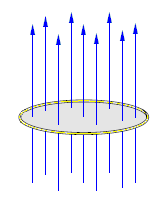Magnetic Flux: Difference between revisions
No edit summary |
|||
| Line 2: | Line 2: | ||
Magnetic Flux is the measure of the strength of a magnetic field over a given area. <ref>http://www.google.com/search?hl=en&safe=off&client=firefox-a&rls=org.mozilla:en-US:official&hs=lBE&defl=en&q=define:magnetic+flux&ei=gsNKS7r4EYuqsgPdmMT_Bg&sa=X&oi=glossary_definition&ct=title&ved=0CAcQkAE</ref>The Greek letter used to represent flux is Φ, phi. The SI unit for magnetic flux is the Weber. The area used must be perpendicular to the | Magnetic Flux is the measure of the strength of a magnetic field over a given area. <ref>http://www.google.com/search?hl=en&safe=off&client=firefox-a&rls=org.mozilla:en-US:official&hs=lBE&defl=en&q=define:magnetic+flux&ei=gsNKS7r4EYuqsgPdmMT_Bg&sa=X&oi=glossary_definition&ct=title&ved=0CAcQkAE</ref>The Greek letter used to represent flux is Φ, phi. The SI unit for magnetic flux is the Weber. The area used must be perpendicular to the | ||
travel of[[Image:Magnetic_flux.png|right|thumb|300px|Figure 1: Magnetic Flux]]the magnetic lines. The flux can then be determined by how many magnetic lines go | travel of[[Image:Magnetic_flux.png|right|thumb|300px|Figure 1: '''Magnetic Flux''']]the magnetic lines. The flux can then be determined by how many magnetic lines go | ||
through the area surface. The net flux is the number of magnetic lines going through the area surface in one direction minus the number magnetic lines going through the surface area in the opposite direction. The general quantitative expression for finding magnetic flux is: | through the area surface. The net flux is the number of magnetic lines going through the area surface in one direction minus the number magnetic lines going through the surface area in the opposite direction. The general quantitative expression for finding magnetic flux is: | ||
Revision as of 00:17, 11 January 2010
Magnetic Flux
Magnetic Flux is the measure of the strength of a magnetic field over a given area. <ref>http://www.google.com/search?hl=en&safe=off&client=firefox-a&rls=org.mozilla:en-US:official&hs=lBE&defl=en&q=define:magnetic+flux&ei=gsNKS7r4EYuqsgPdmMT_Bg&sa=X&oi=glossary_definition&ct=title&ved=0CAcQkAE</ref>The Greek letter used to represent flux is Φ, phi. The SI unit for magnetic flux is the Weber. The area used must be perpendicular to the
travel of

the magnetic lines. The flux can then be determined by how many magnetic lines go
through the area surface. The net flux is the number of magnetic lines going through the area surface in one direction minus the number magnetic lines going through the surface area in the opposite direction. The general quantitative expression for finding magnetic flux is:
where
- B is the magnetic field
- A is the surface area<ref>http://en.wikipedia.org/wiki/Magnetic_flux</ref>
If specific situations arise and more variables are known the calculations for magnetic flux can become relatively simple. Other forms of the flux equation are as follows:
where
- V= Voltage
- T= Time
- N= Number of Turns of wire used
Using Magnetomotive force and the Reluctance
where
- F_m= Magnetomotive Force
- R_m= Reluctance
Using Ohm's Law
where
- I= Current
- L= Inductance
- N= Number of Turns of wire used<ref>http://info.ee.surrey.ac.uk/Workshop/advice/coils/terms.html</ref>
Using Area and Magnetic Flux Density
where
- A= Area of surface where density is measured
- B_m=Magnetic Flux Density<ref>Electric Drives an Integrated Approach,Mohan, Ned,2003</ref>
References
<references/>